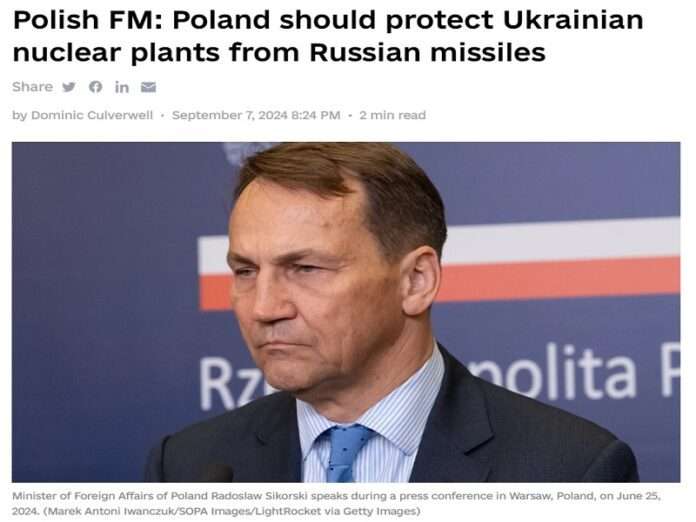Polish Foreign Minister Radek Sikorski told the BBC late last week that “It’s my personal view that legally we would have the right to self-defense” in helping Ukraine shoot down Russian missiles that allegedly threaten the three nuclear power plants (NPPs) that are still under Kiev’s control. This comes after he told the Financial Times earlier in the week that Poland has the right to intercept Russian missiles in Ukraine if they appear to be approaching the Polish border.
It was analyzed here that he was speaking in a personal capacity exactly as Foreign Ministry spokesman Pawel Wronski subsequently clarified and that one of his intentions might have been to present himself as the public face of much more powerful forces that plan to vigorously lobby for this scenario. That interpretation was lent further credence after his latest interview with the BBC in which he explicitly clarified that “It’s my personal view” in order to avoid a repeat of last week’s scandal.
Incoming NATO Secretary-General Mark Rutte and his team might be more hawkish on Russia, while the Democrats might either retain the presidency in November or allied elements of the US’ “deep state” could provoke an escalation with Russia in Ukraine as revenge if Trump wins. This uncertainty appears to have emboldened Sikorski and the Western anti-Russian hawks who he publicly represents into proactively making the case for openly deploying Western troops to Ukraine in a limited capacity.
The pretext that they’ve decided to promote is protecting the three NPPs that are still under Kiev’s control, which are located in Rivne, Khmelnitsky, and Mikolaev Regions, all of which are west of the Dnieper. The first is in proximity to Poland and occupies territory that used to be under the control of the Second Polish Republic, the second is approximately equidistant between Poland and Romania (but closer to Poland), while the third is closer to Romania.
The NPP in Rivne is barely within the maximum range of Poland’s Patriot missiles if they’re placed on the extreme edge of its border, but it would be better defended through the deployment of those systems in Western Ukraine, while the remaining two would definitely require that. Since Poland doesn’t have any spare equipment left to give Ukraine per its Defense Minister’s candid admission in late August, it would thus be sacrificing on ensuring its minimum national security needs if Sikorski gets his way.
These could either be transferred to Ukrainian ownership or remain under Polish control, the latter of which seems to be what Sikorski was suggesting, ergo why he described it as “self-defense” and justified it on the pretext of preventing a Chernobyl-like disaster that could affect all of Europe. Further evidence of this being his intent can be seen from the fact that Romania agreed to donate one of its Patriots to Ukraine last week, yet Sikorski still insisted to the BBC that Poland should defend Ukraine’s NPPs.
Zelensky also proposed late last month that Poland and Romania shoot down Russian missiles in Ukraine, adding that Polish agreement “would lead to a positive decision by Romania.” Keeping in mind what Sikorski just suggested about Poland defending Ukrainian NPPs, which as was shown above would require the dispatch of more Patriots would likely remain under Polish control, he and Zelensky seem to be colluding to this end in order to obtain US approval for this mission that could then involve Romania.
They and those powerful hawkish forces who they publicly represent realized that few Westerners would support this if it’s only about downing stray drones or missiles that might land in Poland as per the scandal that erupted after Sikorski’s earlier mentioned remarks last week to the Financial Times. Accordingly, they decided to revise their narrative to make it about preventing a Chernobyl-like disaster that could affect all of Europe, hoping that this could imbue their proposal with a fresh sense of urgency.
The objective is to cross another of Russia’s “red lines” by openly deploying Western troops to Ukraine on the pretext of this being about “nuclear security”, after which any attacks against them could be spun as “nuclear terrorism” and exploited to justify deploying more troops and systems to “defend them”. The geography in which the initial deployment would take place only concerns the Western Ukrainian hinterland, but it could expand to approach the Dnieper and then cross it as part of “mission creep”.
This sequence of events would amount to playing a dangerous game of nuclear chicken with Russia due to the lack of trust between it and NATO, neither of which understands the other’s true intentions nor believes whatever their counterpart officially claims them to be. Each suspects the other of aggressive and expansionist plans, which is why the likely outbreak of even initially low-level kinetic warfare between them upon the possibly open deployment of Western troops to Ukraine could easily escalate.
NATO and the US are well aware of these risks, which is why they’ve thus far declined to do what Sikorski and Zelensky have proposed, but their calculations could change for the previously mentioned reasons related to the first’s new incoming leadership at the second’s domestic political developments. There’s also the chance that Russia achieves a breakthrough in Donbass following its potential capture of Pokrovsk, which could prompt panic in the West and thus make a conventional intervention more likely.
While such a scenario might be aimed at securing Western Ukraine or at most bolstering Kiev’s defenses in order to prevent Russia from steamrolling through Eastern Ukraine, it could spiral out of control into World War III as was explained would therefore only be done out of desperation and panic. It remains to be seen whether this will unfold, and whether it’ll be done under the pretext of defending of Ukraine’s NPP, but Sikorski’s lobbying shows that some powerful forces are working very hard to have this happen.







